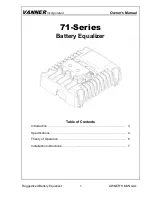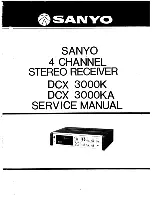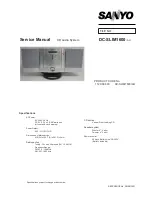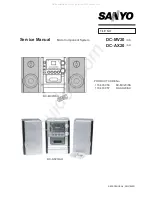
And Why Parallel?
The Massive Passive is a "parallel design" as opposed to the
far more common "series design". A few pages back, we
mentioned the main reason for going with a parallel design
was to avoid extreme signal loss, which would require extreme
gains and present the problem of noise or extreme cost. The
parallel approach not only avoided this but has a number of
advantages as well.
With the series EQ design, if you set 3 bands to boost the same
frequency 15 dB each, the total boost will be band one plus
two plus three - or 45 dB - but then it would probably be
distorting in a rather ugly way. With the Massive Passive, you
can dial in 4 bands to boost 20 db near 1K and it still will only
boost 20 dB total. If you tend to boost 4 bands at widely
separated frequencies (like what happens on two day mixes
with sneaky producers), it tends sound almost flat, but louder.
Other EQs seem to sound worse and worse as you boost more
and more. For some people it will act as a "safety feature" and
prevent them from goofy EQ. Occasionally, you may be
surprised with what looks like radical settings and how close
to flat it sounds. A side effect is that if you are already boosting
a lot of highs in one band, if you attempt to use another band
to tweak it, the second band will seem rather ineffective. You
may have to back off on that first band to get the desired tone.
You actually have to work at making the Massive Passive
sound like heavy-handed EQ by using a balanced combination
of boosts and cuts. In a sense it pushes you towards how the
killer engineers always suggest to use EQs (ie gentle, not
much, more cut than boost). This is good.
While there may be interesting arguments against any
interaction between EQ bands, the reasons tend to be more for
purely technical biases than based on listening. In nature and
acoustics and instrument design, very little of the factors that
affect tone are isolated from each other. Consider how a
guitar's string vibrates the bridge which vibrates the sound
board, resonates in the body, and in turn vibrates the bridge
and returns to the string. What is isolated? The fact that the
bands are NOT isolated from each other in the Massivo is one
of the reasons it does tend to sound more natural and less
electronic. We noticed this effect in a few passive graphic
EQs, notably the "560" and a cut-only 1/3 octave EQ.
There is a type of interaction we did avoid. That is inductor to
inductor coupling. It is caused by the magnetic field created
by one inductor to be picked up by another. It can cause the
inductors to become an unexpected value, or if it is band to
band, can cause effects that can best be described as goofy. In
the Filter Section we utilized close inductor spacing to get
some hum-bucking action but avoid magnetic coupling with
careful positioning. Some kinds of interaction suck and some
are beneficial.
Why Passive?
If you hate tech talk, just skip this section - it has to do with
electronic parts and circuits and design philosophy.
All EQs use capacitors. They are very easy to use, predictible,
cheap and simple. Some sound slightly better than others.
Inductors do almost the mirror function of capacitors.
Unfortunately, they can be difficult to use (they can pick up
hum), they can be difficult to predict (the essential inductance
value usually depends on the power going through them
which varies with audio), they are expensive and generally
have to be custom made for EQs. These are qualities that lab-
coat engineers tend to scowl at. Some effort was aimed at
replacing the poor inductors and more effort made to bad-
mouth them and justify these new circuits. The main reason
was cost. All of the "classic" Eqs used real inductors and that
has become the dividing line "sought after vintage" and just
old.
What the lab-coats didn't consider was that inductors may
have had real but subtle advantages. Is it only obvious to
"purists" that a coil of copper wire may sound better than 2 or
3 op-amps, each with over twenty transistors, hundreds of dBs
of negative feedback along with "hiss", cross-over distortion
and hard harsh clipping?
We mentioned the inductance value can change with applied
power. This also turns out to be a surprising advantage. For
example, in the low shelf, with heavy boosts and loud low
frequency signals, at some point, the inductor begins to
saturate and loses inductance. Sort of a cross between an EQ
and a low freq limiter. The trick is to design the inductor to
saturate at the right point and in the right way.
In the mid-bands and bell curves a somewhat different effect
happens. The center-frequency shifts slightly depending on
both the waveform and signal envelope. This "sound" is the
easily recognizeable signature of vintage EQs. It is not a type
of harmonic distortion (though it can be mistaken for this on
a test-bench) but more of a slight modulation effect.
Inductors in the form of transformers are also a large part of
why vintage gear is often described as "warm" whether it was
built with tubes or transistors. In fact, the quality of the
transformer has always been directly related to whether a
piece of audio gear has become sought after. Saturation in this
case involves adding odd harmonics to very low frequencies
which either tends to make lows audible in small speakers or
makes the bass sound louder and richer (while still measuring
"flat"). The key is how much. A little seems to be sometimes
desireable (not always) and a little more is beginning to be
muddy and a little more can best be described as "blat". The
number of audio transformer experts has fallen to a mere hand
full and some of them are getting very old.
11













































